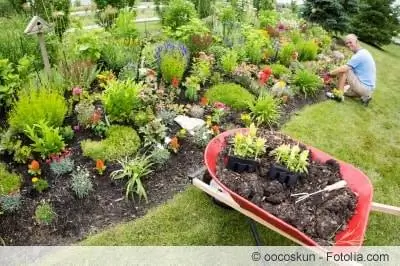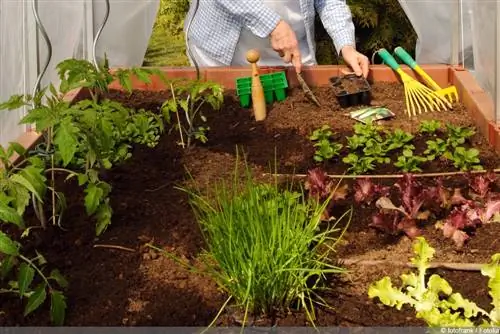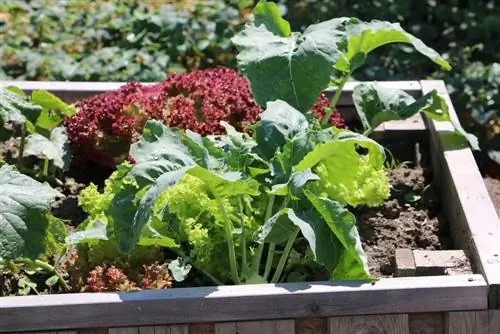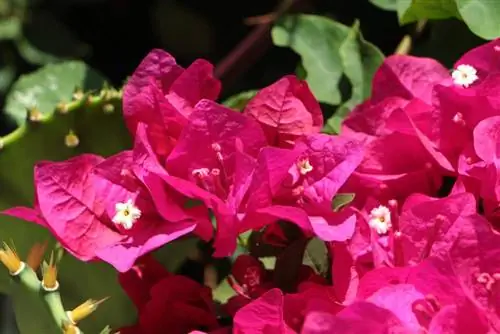- Author admin [email protected].
- Public 2023-12-17 03:39.
- Last modified 2025-01-24 12:45.
A wonderfully beautiful oasis of opulence, this is how an ever-blooming bed in the garden presents itself as it travels through the seasons. Creative gardeners create this magnificent silhouette by combining different types of plants. If similar plants appear in two or a maximum of three basic colors in small islands in different bed locations, you create creative harmony instead of a jumbled together hodgepodge. Here you can find out what else is important to create a stylish bed with plants that bloom all year round. Bulb flowers and dwarf shrubs ring in the gardening year.
The top priority for an ever-flowering bed is: include all types of plants. If only perennials are used, you won't be able to look forward to the first flowers until April at the earliest. Just a few flower bulbs, paired with lush dwarf shrubs, start the flowering procession in February. Suitable candidates are:
- Flower bulbs: Snowdrops, tulips, crocuses, winter aconites, daffodils and anemones
- Shrubs: Rose forsythia (Abeliophyllum distichum), gorse (Cytisus beanii) , shadow bells (Pieris japonica), star magnolia (Magnolia stellata)
Spring shrubs give the bed structure during the winter and create visual resting points. Bulb flowers have the advantage that they retreat after flowering to make room for the following perennials.
Tip:
You can add extra spirit to an ever-flowering bed by placing planted containers in it. Depending on the seasons, the pots are replanted again and again or they are decorated with perennial climbing plants that climb decoratively up integrated obelisks.
Continuous flowering perennials
They give the appearance consistency and serve as a visual support for short-term flower beauties. Perennial flowering perennials are essential in a plant composition that aims for continuity. They are therefore intended to have a dominant presence in the foreground. Short-blooming plants such as peonies (Paeonia) or Turkish poppies (Papaver orientalis) are ideally placed in the background, as they leave unsightly gaps after their splendor. The following perennials are particularly characterized by their never-ending flowering period:
- Bertram's Sheaf (Achillea ptarmica 'Snowball'), a historic perennial with lush, double, white flowers
- Scented Nettle (Agastache hybrid 'Linda'), with purple-violet labial flowers until the first frost
- Large-flowered girl's eye (Coreopsis grandiflora), flaunts bright yellow flowers from June to October
- Dyer's Chamomile (Anthemis tinctoria), which provides subtle abundance with silver-gray foliage under cream-colored flowers
- Lavender (Lavandula angustifolia), an indispensable classic for the sunny perennial bed
- Star Umbel (Astrantia major), its pink ray blossom appears a second time after pruning
- Stork's beak (Geranium wallichianum), responsible for colorful splashes of color in the bed until well into autumn
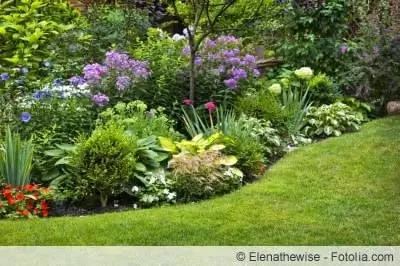
If the continually blooming perennials are joined by elegant ornamental grasses, autumn will not leave any sadness in the bed. Miscanthus(Miscanthus sinensis),Blue beachcomb(Ammophila breviligulata),Beardgrass(Andropogon) or the delicate oneRainbow Fescue (Festuca amthystina) master this task with flying colors.
Bed and small shrub roses with repeated abundance of flowers
The ever-blooming bed should not be missing the frequently blooming bed and small shrub roses. In contrast to sensitive noble roses, these types of roses are also robust and easy to care for. The following varieties may serve as inspiration for an individual rose composition in your garden:
- Bedding rose 'Abracadabra' creates a cheerful ambience with red, white and yellow striped and double flowers
- Bedding rose 'Airbrush' impresses with its abundance of orange-yellow and cream-colored marbled flowers
- Small shrub rose 'Diamant' lays its pure white flowers at the feet of the tall perennials
- Small shrub rose 'Romantic Roadrunner' combines the vigor of a wild rose with the beauty of the floribunda rose
- Bedding rose 'Garden of Roses' scores with a pastel pink flower and a bushy habit
If you arrange roses that bloom more often in small groups, they will be particularly decorative. They are also ideal for adding greenery to a wall or fence, as long as the bed is bordered in this way.
Tireless rose companions
The breathtaking beauty of bed and small shrub roses comes into its own when they thrive in the bed with the right accompaniment. Such perennials do not strive to steal the show from the roses. Rather, they are intended as effective background music. Of course, only perennials that can keep up with the noble protagonists in terms of flowering duration are considered. Some outstanding candidates for this role are these:
- Columbine (Aquilegia Vulgaris), whose hybrids try to hide their toxicity with double and simple flowers
- Dotted Bellflower (Campanula Punctata) develops its distinctive, violet flowers from June to October
- Pyrenean Aster (Aster pyrenaeus), forms a nice contrast to round rose petals with its umbel panicles
- Dark spur (Delphinium Elatum) harmonizes wonderfully with roses and forms powerful clumps over time
- Silverrue (Artemisia ludoviciana var. albula), lives up to the name with its silvery-gray foliage
- Steinquendel (Calamintha nepeta) not only blooms constantly, but also spreads a wonderful scent
- White foxglove (Digitalis purpurea) decorates the bed with mighty flower candles in bright white
In addition to the brilliant blooms of remontant roses, evergreen trees can also be considered as a backdrop. Boxwood(Buxus) andCherry Laurel(Prunus laurocerasus) are ideal, as is the smallCotoneaster(Cotoneaster) orIvy (Hedera helix) as decorative and practical ground cover.
Winter flowering plants
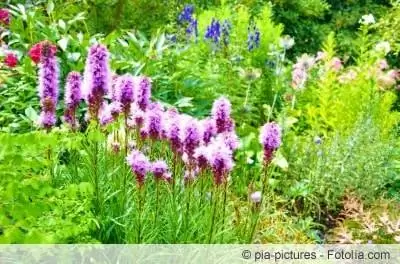
They actually exist, the magicians among flowering plants that add colorful splashes of color in winter. The plant community in the ever-flowering bed is rounded off by the following species and varieties:
- Mahonia (Mahonia media 'Winter Sun') a wonderful winter bloomer with yellow flowers from January
- Snow Heath (Erica carnea 'Golden Starlet') has the strength to bloom in winter despite its 15 cm height
- Snow cherry (Prunus subhirtella) blooms non-stop in the mild winter from November to April
- Winter honeysuckle (Lonicera purpusii) spreads a summery scent in the middle of winter with creamy white flowers
- Magic hazel (witch hazel), the undisputed flower queen of winter with pink-white or yellow flowers
The winter viburnum (Viburnum bodnantense 'Dawn') is a winter bloomer with a fascinating appearance and wonderful scent. You can hardly believe your eyes when you see the splendor of pink flowers in the midst of barren nature. This festival of colors continues into April, so this ornamental shrub definitely deserves a place in the permanently blooming bed. The Christmas rose (Helleborus) is not inferior in magic, demonstrating its powerful presence from December until spring.
Tips for investing
For the charisma of an ever-blooming bed to fully unfold, it's not just about a creative planting plan. Some sober aspects also help ensure that the plants that bloom all year round meet the expectations placed on them.
- The bed has a minimum area of 15 to 20 square meters
- Ideally, the plants will find nutrient-rich, humus-rich garden soil
- The location is sunny to partially shaded, without any particular exposure to wind
- Before planting, the soil is enriched with mature compost and, if necessary, a little sand
- Adequate water supply in the first few weeks creates the best conditions for growth
- When planting new plants in autumn, winter protection is essential for the young plants in the first year
Cautious hobby gardeners do not neglect to spread a sturdy weed fleece under the potting soil. This is an innovative geotextile that, on the one hand, is permeable to water and air and, on the other hand, effectively prevents any weeds from growing. Conventional plastic film does not come close to meeting these requirements.
Choosing the appropriate planting distance within this diverse community often causes uncertainty among gardeners. Although the respective plant species defines the exact distance, you can still plant according to the following rule of thumb: 5-6 perennials with normal growth per square meter, and 2-3 plants for sprawling species. Plant small-growing or ground-covering bedding perennials with 6-8 specimens per square meter of area.
Conclusion
Stop dreaming of an ever-blooming bed and put the plan into action. In order to populate a bed with plants that bloom all year round, it is important to have a balanced combination of species and varieties that are characterized by a long flowering period. Bulb flowers and early-flowering shrubs take on this task early in the year, followed by perennials from April onwards. It is the perennials that play the main role in this multifaceted society. Of course, roses that bloom more often should not be missing, paired with distinctive companion plants. Even in the winter, Mother Nature has flowering plants in store that ensure a pretty flower bloom in the bed. In order for a continuously flowering bed to fully develop its charisma, it should have an appropriate area of at least 15 to 20 square meters.

